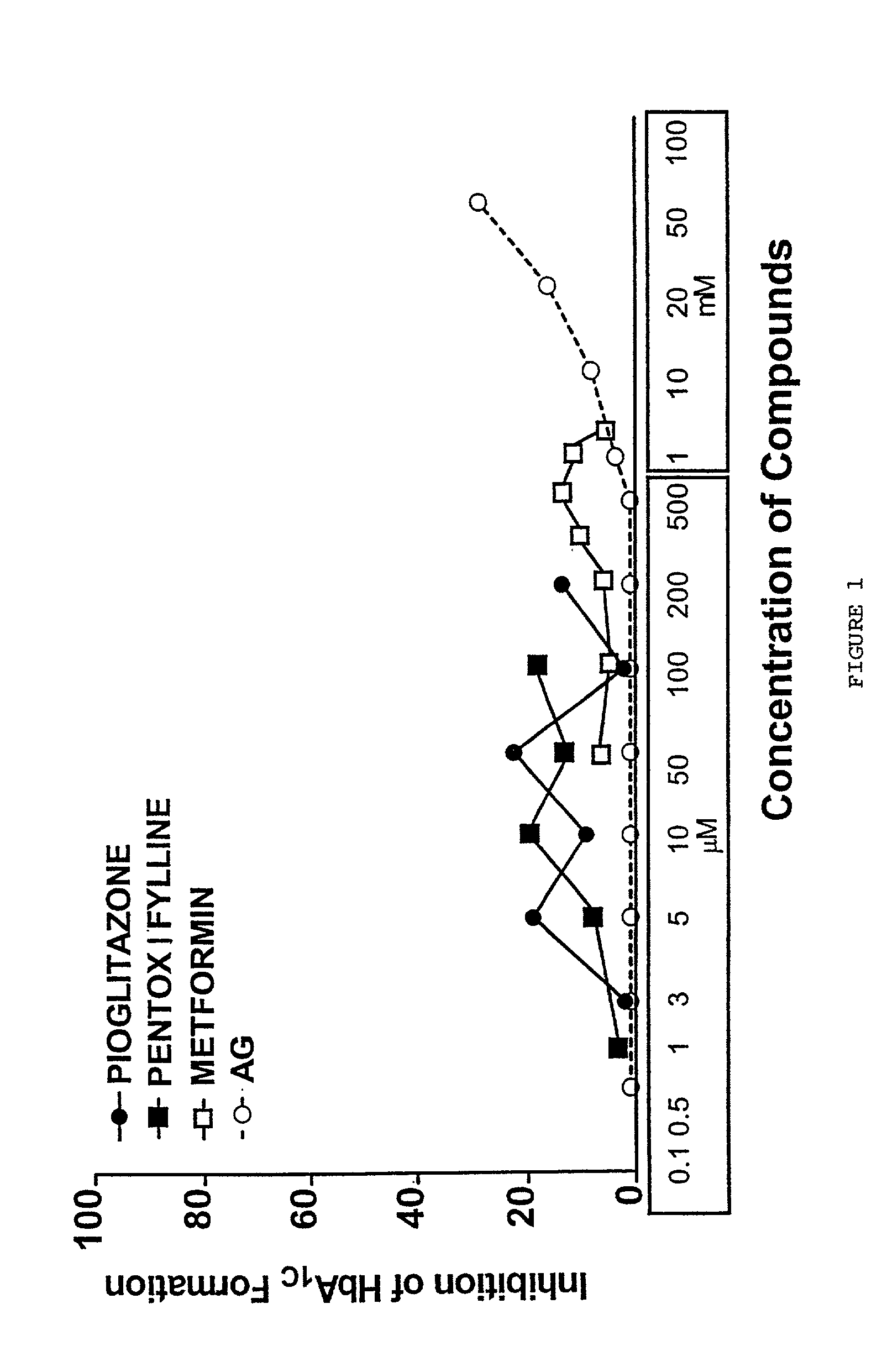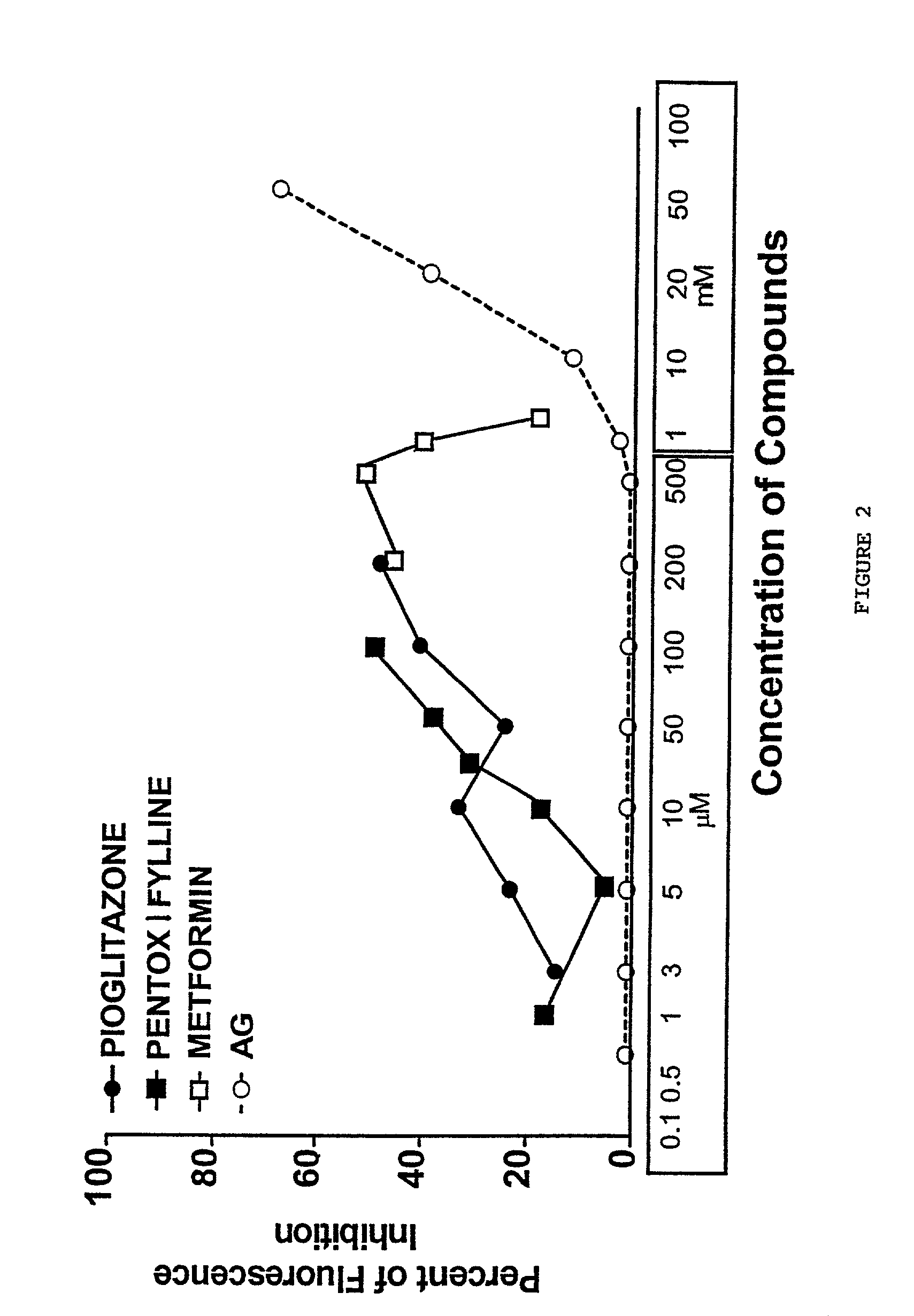Pentoxifylline, pioglitazone and metformin are inhibitors of formation of advanced glycation endproducts (AGE's)
a technology of glycation endproducts and pentoxifyllines, which is applied in the direction of biocide, drug composition, metabolic disorders, etc., can solve the problems of severe consequences, inhibit and inhibit the nonenzymatic glycation of proteins. , to prevent discoloration of teeth, inhibit the effect of some of the ill effects
- Summary
- Abstract
- Description
- Claims
- Application Information
AI Technical Summary
Benefits of technology
Problems solved by technology
Method used
Image
Examples
example 1
Hemoglobin-.delta.-Gluconolactone (.delta.-Glu) Assay
[0031] Evaluation of early glycation products (Amadori) formation on hemoglobin (HbA.sub.1C) is performed by incubating red blood cells with an oxidized form of glucose in the presence and the absence of the inhibitor compound followed by determination of (HbA.sub.1C) in the test versus the control (Rahbar and Nadler, 1999). This test is based on a recent report by Lindsay et al. (1997). .delta.-Glu, an oxidized analogue of glucose, can react rapidly with hemoglobin within the red cells and significantly increases the HbA.sub.1C levels within hours after incubation. By contrast, glucose requires weeks for an equivalent reaction to occur. We have used this finding to devise an assay method to measure early stage glycation of hemoglobin (Amadori product) and an assay to evaluate the ability of an inhibitor to inhibit HbA.sub.1C formation. Briefly, fresh blood was drawn in potassium-EDTA and prepared for incubation within 30 minutes ...
example 2
BSA-Glucose Assay
[0035] This test is used to evaluate the ability of the inhibitors to inhibit glucose-mediated development of fluorescence of BSA (Ikeda et al., 1996). BSA (fraction V) from Sigma 50 mg / mL and 800 mM glucose (144 mg / mL) in 1.5 M phosphate buffer pH 7.4 containing NaN.sub.3 0.2 g / L was incubated under aseptic conditions at 37.degree. C. for 7 days in the presence or absence of various concentrations of the compounds. After 7 days of incubation each sample was examined for the development of specific fluorescence (excitation, 370 nm; emission, 440 nm). The % inhibition of AGE formation in the test sample versus control was calculated for each inhibitor compound. Aminoguanidine was used as a positive control.
[0036] FIG. 2 shows for each of the three compounds as well as for aminoguanidine the inhibitory effects of for a range of concentrations for each compound. The results obtained by this assay show that all of the compounds have a strong inhibitory effect on the pos...
example 3
[0037] N-Acetyl-Glycyl-Lysine Methyl Ester (G.K. Peptide)-Ribose Assay
[0038] Evaluation of the late glycation products (AGE's), and AGE-inhibition by the new inhibitor compounds was tested by incubation of G.K. peptide in ribose in the presence or the absence of the agent, followed by determination of chromophores generated in the course of glycation and AGE formation through determination of their specific fluorescence. The Nagaraj et al. (1996) method used to evaluate the ability of the compounds of the present invention to inhibit the crosslinking of N-acetylglycyl-lysine methyl ester in the presence of ribose was as follows:
[0039] Stock Solutions
[0040] 0.5 M sodium phosphate buffer pH 7.4 containing NaN.sub.3 0.2 g / L
[0041] GK peptide (Sigma) 80 mg / mL in 0.5 M sodium phosphate buffer pH 7.4
[0042] Ribose 800 mM (120 mg / mL) in 0.5 M phosphate buffer
[0043] Equal volumes (0.1 mL) of the 3 stock solutions were mixed together, filtered through a 0.2 micron filter (Corning) and incubate...
PUM
 Login to View More
Login to View More Abstract
Description
Claims
Application Information
 Login to View More
Login to View More - R&D
- Intellectual Property
- Life Sciences
- Materials
- Tech Scout
- Unparalleled Data Quality
- Higher Quality Content
- 60% Fewer Hallucinations
Browse by: Latest US Patents, China's latest patents, Technical Efficacy Thesaurus, Application Domain, Technology Topic, Popular Technical Reports.
© 2025 PatSnap. All rights reserved.Legal|Privacy policy|Modern Slavery Act Transparency Statement|Sitemap|About US| Contact US: help@patsnap.com



